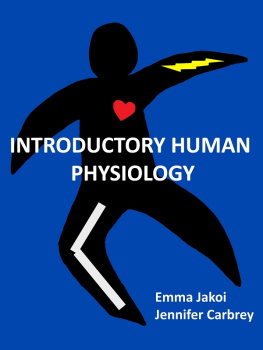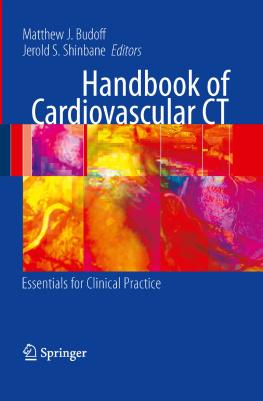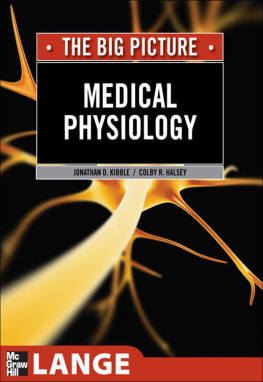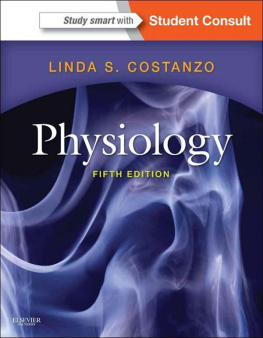Cardiovascular Physiology
Notice
Medicine is an ever-changing science. As new research and clinical experience broaden our knowledge, changes in treatment and drug therapy are required. The authors and the publisher of this work have checked with sources believed to be reliable in their efforts to provide information that is complete and generally in accord with the standards accepted at the time of publication. However, in view of the possibility of human error or changes in medical sciences, neither the authors nor the publisher nor any other party who has been involved in the preparation or publication of this work warrants that the information contained herein is in every respect accurate or complete, and they disclaim all responsibility for any errors or omissions or for the results obtained from use of the information contained in this work. Readers are encouraged to confirm the information contained herein with other sources. For example and in particular, readers are advised to check the product information sheet included in the package of each drug they plan to administer to be certain that the information contained in this work is accurate and that changes have not been made in the recommended dose or in the contraindications for administration. This recommendation is of particular importance in connection with new or infrequently used drugs.
a LANGE medical book
Cardiovascular Physiology
7th edition
David E. Mohrman, PhD
Associate Professor
Department of Physiology and Pharmacology
University of Minnesota Medical School
Duluth, Minnesota
Lois Jane Heller, PhD
Professor
Department of Physiology and Pharmacology
University of Minnesota Medical School
Duluth, Minnesota


Copyright 2010, 2006, 2003, 1997, 1991, 1986, 1981 by The McGraw-Hill Companies, Inc. All rights reserved. Except as permitted under the United States Copyright Act of 1976, no part of this publication may be reproduced or distributed in any form or by any means, or stored in a database or retrieval system, without the prior written permission of the publisher.
ISBN: 978-0-07-176652-4
MHID: 0-07-176652-9
The material in this eBook also appears in the print version of this title: ISBN: 978-0-07-170120-4, MHID: 0-07-170120-6.
All trademarks are trademarks of their respective owners. Rather than put a trademark symbol after every occurrence of a trademarked name, we use names in an editorial fashion only, and to the benefit of the trademark owner, with no intention of infringement of the trademark. Where such designations appear in this book, they have been printed with initial caps.
McGraw-Hill eBooks are available at special quantity discounts to use as premiums and sales promotions, or for use in corporate training programs. To contact a representative please e-mail us at bulksales@mcgraw-hill.com.
TERMS OF USE
This is a copyrighted work and The McGraw-Hill Companies, Inc. (McGraw-Hill) and its licensors reserve all rights in and to the work. Use of this work is subject to these terms. Except as permitted under the Copyright Act of 1976 and the right to store and retrieve one copy of the work, you may not decompile, disassemble, reverse engineer, reproduce, modify, create derivative works based upon, transmit, distribute, disseminate, sell, publish or sublicense the work or any part of it without McGraw-Hills prior consent. You may use the work for your own noncommercial and personal use; any other use of the work is strictly prohibited. Your right to use the work may be terminated if you fail to comply with these terms.
THE WORK IS PROVIDED AS IS. McGRAW-HILL AND ITS LICENSORS MAKE NO GUARANTEES OR WARRANTIES AS TO THE ACCURACY, ADEQUACY OR COMPLETENESS OF OR RESULTS TO BE OBTAINED FROM USING THE WORK, INCLUDING ANY INFORMATION THAT CAN BE ACCESSED THROUGH THE WORK VIA HYPERLINK OR OTHERWISE, AND EXPRESSLY DISCLAIM ANY WARRANTY, EXPRESS OR IMPLIED, INCLUDING BUT NOT LIMITED TO IMPLIED WARRANTIES OF MERCHANTABILITY OR FITNESS FOR A PARTICULAR PURPOSE. McGraw-Hill and its licensors do not warrant or guarantee that the functions contained in the work will meet your requirements or that its operation will be uninterrupted or error free. Neither McGraw-Hill nor its licensors shall be liable to you or anyone else for any inaccuracy, error or omission, regardless of cause, in the work or for any damages resulting there from. McGraw-Hill has no responsibility for the content of any information accessed through the work. Under no circumstances shall McGraw-Hill and/or its licensors be liable for any indirect, incidental, special, punitive, consequential or similar damages that result from the use of or inability to use the work, even if any of them has been advised of the possibility of such damages. This limitation of liability shall apply to any claim or cause whatsoever whether such claim or cause arises in contract, tort or otherwise.
Contents
Preface
This text is intended to give beginning medical and serious physiology students a strong understanding of the basic operating principles of the intact cardiovascular system. In the course of their careers, these students will undoubtedly encounter a blizzard of new research findings, drug company claims, etc. Our basic rationale is that to be able to evaluate such new information, one must understand where it fits in the overall picture.
In many curricula, the study of cardiovascular physiology is a students first exposure to a complete organ system. Many students who have become masters at memorizing isolated facts understandably have some difficulty in adjusting their mindset to think and reason about a system as a whole. We have attempted to foster this transition with our text and challenging study questions. In short, our goal is to have students understand rather than know cardiovascular physiology.
We are also conscious of the fact that cardiovascular physiology is allotted less and less time in most curricula. We have attempted to keep our monograph as short and succinct as possible. Our goal from the first edition onward has been to help students understand how the bottom-line principles of cardiovascular operations apply to the various physiological and pathological challenges that occur during everyday life. Thus, our monograph is aimed throughout with its last two chapters in mind. These chapters bring together the individual components to show how the overall system operates under normal and abnormal situations. We judged what facts to include in the beginning chapters on the basis of whether they needed to be referred to in these last two chapters.
In this seventh edition, we have attempted to hone our fundamental approach through more precise language, better organization of some of the material, incorporation of a few new factual updates that clarify our understanding of basic concepts, and inclusion of additional thought-provoking study questions.
As always, we wish to express sincere thanks to our mentors while we were students and to our own students for all the things they have taught us over the years.
David E. Mohrman, PhD
Lois Jane Heller, PhD
1 Overview of the Cardiovascular System
OBJECTIVES
The student understands the homeostatic role of the cardiovascular system, the basic principles of cardiovascular transport, and the basic structure and function of the components of the system
Next page








